-
Claire Denis: BASTARDS (2013)
CLAIRE DENIS: BASTARDS (2013)
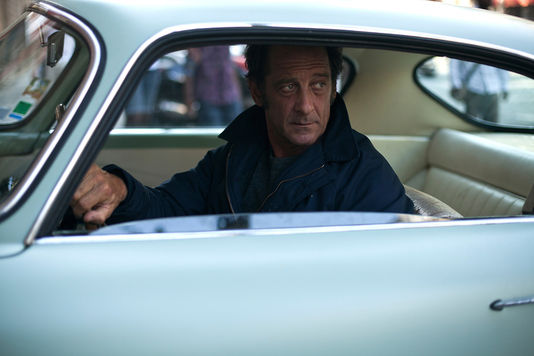
Vincent Lindon ant the pretty Alfa Romeo in Bastards
Pleasing mystification not so good when it comes clear?
This is one of Denis's puzzlers, like The Intruder, except it's not that pleasurably mysterious, and lacks its vigorous, tonic physicality, unless you call moments of sex and violence that. Many of the usual players are there, with Vincent Lindon of Friday Night in the foreground throughout, Michel Subor as a morally dubious rich man again, Alex Descas of 35 Shots of Rum, and others seen before, including Grégoire Colin, seen almost always. Actually while it provides few points of obvious reference, up to a point Bastards is easy to explain compared to The Intruder. A ship's captain, Marco Silvestri (Lindon) comes back to find his family is losing their shoe factory and has been involved in some ugly corruption (drugs, sex) that he didn't know about. He occupies a nearly empty flat in a nice ("Haussmanian") building -- to observe dubious magnate Edouard Laporte (Subor), and start screwing Laporte's mistress Raphaëlle (Chiara Mastroianni), with whom she shares a little boy, "little Joseph" (Yann Antoine Bizette).
Other characters include Marco's sister Sandra (Julie Bataille); whose husband Jacques (Laurent Grevill) commits suicide in the opening scene, being massively in debt to Laporte; and a young woman, evidently their daughter Justine (Lola Créton), traumatized by devious practices, who wanders the streets at night stark naked except for high heels. She has been in the care of a Dr. Béthanie (Descas), who's also a psychiatrist. Involved in a scene of orgies out in the country, which Marco visits, are several people glimpsed fleetingly, including Xavier (Colin). Marco's behavior is mysterious. He sells a valuable watch, and then to a friend and former naval associate who collects cars, he sells his pretty robin's egg blue Alfa Romeo. Evidently he has taken time off to help his sister deal with the debuts, and to observe Laporte. These elements accumulate by an achronological precess of accretion rather than conventional narrative flow.
Various cool, mysterious, vaguely exciting, and eventually disquieting things go on that may be more interesting when we don't yet understand what they are. The view of Mike D'Angelo, who saw the film when it debuted in Un Certain Regard at Cannes, is that it can be compared to Assayas' Demonlover, also related to corporate evil and devious sex, also cool, but mundane when it reveals its secrets toward the end. D'Angelo points out this is loosely based on Faulkner's Sanctuary. He recounts some hocus-pocus having to do with a bar of soap and a shirt, and the repair of the boy's bike used as an intro between Marco and Raphaëlle. D'Angelo concludes, "while Bastards is never less than enthralling while it unravels, its resolution—again, like that of Demonlover—feels shallowly sordid, as if the entire movie was really just a prolonged moralistic scold cleverly disguised as something richer and more mysterious." And he thinks this will be a footnote to Denis' main filmography, which follows, if his analysis is right. Her collaborator on the writing, as on a number of occasions, was Jean-Pol Fargeau.
This is probably a film that's more fun to analyze than watch, though it also, like The Intruder, will probably be more enjoyable after being more thoroughly worked through. Scott Foundas in Variety, who seems enthusiastic, also notes a link to Kurosawa's The Bad Sleep Well. He describes this as a "hypnotic nocturnal thriller" that exercises a "dreamlike pull." Les salauds (the original title) opened in France in August, where it has mixed press (Allociné 2.9), due to a split between the hipper, more sophisticated journals cited (Les Inrocks, Cahiers) that appreciated and the more mainstream (Le Monde, Télérama) that didn't at all. Even Cahiers found the final explanatory sequence irrelevant and thought it would be more artistically pure without it: why be mysterious and elusive and then explain things? This is probably what D'Angelo's bothered by. Music by usual collaborators Stuart A. Staples and British indie outfit Tindersticks is excellent. Shot by Agnès Godard as usual but in digitial this time.
Bastards/Les salauds, 83 mins., debuted at Cannes May 2013, opened in France 7 Aug., screened for this review as part of the New York Film Festival at Lincoln Center; opens NYC 23 Oct.
Last edited by Chris Knipp; 01-02-2015 at 06:43 PM.
-
Sebastián Lelio: GLORIA (2013)
SEBASTIÁN LELIO: GLORIA (2013)

Paulina García in Gloria
Acknowledging another's unworthiness becomes one's strength
Santiago, Chile, present day: Gloria (Paulina García), a fifty-something woman who's been divorced some years, likes to go dancing. She meets Rodolfo (Sergio Hernández), a man pehaps her own age, recently divorced, who's very interested. A relationship follows. Then things run into trouble when he seems not as free of his former marriage. The ex-wife and two grown daughters do not work, and live off him. And he seems unable to pull free of their cloying dependency. His neuroticism extends to connecting with families. He hides his relationship with Gloria from his daughters, and when invited to Gloria's son's birthday party to meet her ex-husband and his new partner, he is so overwhelmed by their normalcy, he flees unannounced. Gloria breaks off with Rodolfo, but at his continual pleading, resumes it. But trouble looms again. Eventually Gloria triumphs over this failure, as symbolized in a final sequence where she dances and sings Umberto Tozzi's "Gloria", famous as a disco song recorded by Laura Braunigan.
The film follows a simple trajectory, with a few key sequences. First is the meeting of Gloria and Rodolfo. A scene at Rodolfo's outdoor game concession featuring paint guns. Then the birthday party at Gloria's son's place. Then a trip to a resort when Rodolfo fails Gloria again. A semi-comic motif of Gloria at home features her annoying, noisy, perhaps suicidal neighbor upstairs, whose hairless cat keeps sneaking into Gloria's flat.
Gloria's revenge against Rodolfo may have too much a facile feel-good quality. However, this becomes a study in resilience in which a person, and a divorced woman, not probably Latin America's most advantaged, comes to define her strengths by being forced after trying to ignore the warning signs (twice) to see how another human being is unworthy of her.
Paulina García won the Best Actress award at Berlin, and this is indeed a rounded, fearless performance in an unusually rich character study, even if the film is uncomplicated.
Gloria, 110 mins., debuted at Berlin Feb. 2013, shown at numerous other international festivals, including the New York Film Festival (Oct. 2013), where it was screened for this review. Limited US release began 24 January 2014, with extremely positive critical response (Metacritic 83%). Good in France too (19 FEb. 2014 release; AlloCiné press rating 3.7).
Last edited by Chris Knipp; 01-02-2015 at 06:49 PM.
-
Ben Stiller: THE SECRET LIFE OF WALTER MITTY (2013)
BEN STILLER: THE SECRET LIFE OF WALTER MITTY (2013)

Almost "Life"-like
Big studio Hollywood isn't good at maintaining the boundaries between reality and illusion -- whose starkness was the point of James Thurber's classic little short story. The Ben Stiller Secret Life of Walter Mitty distorts James Thurber's idea, as did the 1947 Danny Kaye version, only this time even more so. Stiller's Mitty starts out with the theme of the meek office worker who escapes into fantasies, but tarts it up, and then tosses it away. It also has another theme -- actually several. It's not only about an urban cipher. It's also about the death of print journalism, and about downsizing, even about the glories of film photography compared to digital. There is too much going on here. And at some point it begins to seem this isn't Walter Mitty's fantasy, but Ben Stiller's. Is it Walter, or Ben, reimagining himself as a bold outdoorsman, a mountain climber, and (on an Icelandic highway, no less) a heck of a skateboarder? Oh yes, and he gets the girl (Kristen Wiig). (Thurber's Walter Mitty was a henpecked husband; Danny Kaye had Mommie issues.) And saves the honor of Life Magazine -- whose print edition, miraculously, is just being shut down in 2013. And hobnobs with Sean Penn, in the person of a legendary, maverick photojournalist.
What happened to the fantasies? All this starts to be actually happening. Just like in a movie. Sounds like a Twentieth Century Fox release, and it is. And a Twentieth Century Fox fantasy. Bearing in mind, though, that Stiller has said he "came relatively late" to this project, maybe it's not his fantasy at all.
In any case, this Secret Life limps badly at first, focusing on nerdy Walter's attempt to meet a fellow worker at Life through an online dating service, then shifting, unable to make this theme click (though it keeps belaboring it even in the most unlikely places), to an economic drama: Life Magazine has been sold, and Walter comes face to face with the condescending, odiously bearded Transition Manager (Adam Scott), who, strangely, orders Walter to find the negative of a new shot by legendary photojournalist Sean O'Connell (Sean Penn). It's going to be the cover photo for Life's final issue.
At first the movie shows Walter having fantasies, more or less as in the original Thurber story. He's flying through the air, rescuing animals from a burning building, and so forth. But that doesn't go anywhere, so the writers just gradually drop it.
And with such incoherent writing in Steve Conrad’s screenplay, no wonder there's a disconnect: in the opening scene Walter's got an anonymous little office space. Later, he turns out to be down in a dark library, in charge of the magazine's photo negative file -- a pretty important job, by the way. Other images are on the sheet, but the one requested, no. 25, is missing. Using the ones they've got, this becomes a treasure hunt that somehow takes Walter to Greenland and then to Iceland and finally Afghanistan, in search of the photographer himself. It may not be altogether clear whether Walter has plunged full time into his fantasy world, or has just been inspired by the challenge of finding Life's final, "quintessential" cover image to seek out Sean O'Connell to the ends of the earth. The screenplay forgets Walter Mitty was a guy who (as in Thurber) had a boring life and lived in his fantasies and turns him into a guy whose adventures, now actually happening, are so good he starts to score big on the Web dating site. As often happens with big budget screenwriting, the original concept of the character is tossed out in the interest of lively action.
Finally this movie clicks on some level when it finds some nice locations, notably a surreal little dive bar in a place called Nuuk, Greenland where the men drink beer from giant boot-shaped glasses, and Walter meets a giant, seedy, drunken pilot you could never make up (Ólafur Darri Ólafsson). (This is where Stuart Dryburgh's cinematography, which hitherto looked bright, neutral and generic, finally begins to work.) Stiller now takes on a bronzed, rugged, ultra-healthy look. This is where he dives into the ocean from a helicopter flown by an Icelandic drunk, dodges sharks, and zips cross country on a longboard skateboard he trades from a couple of Icelandic boys for a stretchy doll. He's really doing this stuff. What happened to Walter Mitty? Nonetheless on a simple adventure story level the movie now begins to be fun.
Sean Penn's brief scene is nice. Sitting gnarly and leather-skinned in front of a mammoth telephoto lens, he zeros in on a snow leopard -- giving Walter a peek -- really -- but chooses not to click the shutter. Sometimes he likes to save the moment for himself, he says. A concept for the Instagram, social media generation to ponder.
And the man can act. Even a hokey little scene like this, he can make memorable. Shirley MacLaine (as Walter's mother) and Sean Penn both look like weathered freaks here, out of place in the studio's squeaky-clean version of the imagination. But it's not clear where Ben Stiller's directing begins and ends here. His iconic role was Zoolander, and his best serious acting part was in Greenberg. This Walter Mitty is so distorted he lacks the courage to show the character's neediness and inadequacy. This isn't fantasy. It's "self-realization." In 21st-century Hollywood, the illusions don't end with a jolt. They come true.
The Secret Life of Walter Mitty, 114 mins., was premiered as the Centerpiece film at the New York Film Festival at Lincoln Center, where it was screened for this review. Scheduled for worldwide December release, Christmas Day in the US. (Critical response was poor: Metacritic 54%.)
Last edited by Chris Knipp; 01-02-2015 at 06:51 PM.
-
Steve McQueen: 12 YEARS A SLAVE (2013)
STEVE MCQUEEN: 12 YEARS A SLAVE (2013)
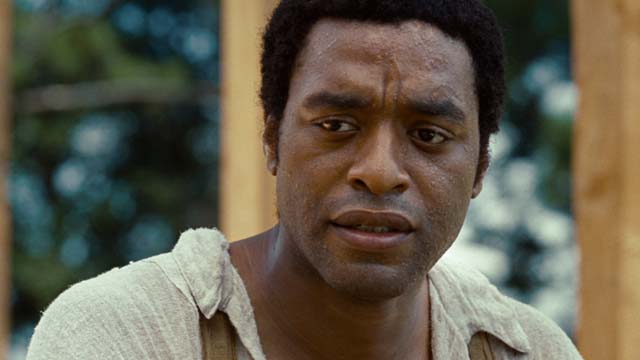
Chewetel Ejiofor in 12 Years a Slave
The ordeal of the ancestors
12 Years a Slave, adapted from the true account by Soloman Northrup, a free black man resident in New York who was kidnapped into slavery from 1841 to 1853 in the South, is British artist Steve McQueen's third feature film, after his powerful debut Hunger (NYFF 2008, about Bobby Sands' fast to the death for the Irish cause) and his less successful Shame (NYFF 2011, about a New York man with an unhealthy obsession with sex). This new one has more mainstream American (or North American) appeal. It takes the material of exploitation Mandingo movies and treats it as straight, ultra-serious, and unsexy -- as well as without humor or witty dialogue, since one can't help but think of Tarantino's recent genre-bending slavery saga Django Unchained, which went over similar subject matter.
Is it safe not to like McQueen's new movie? Given that it has been winning nearly universal praise and got the People's Choice Award at Toronto along with Oscar-bait tweets, it may be unwise. And 12 Years a Slave is beautiful, powerful, and superbly performed. But it suffers from shapelessness and corny or obvious speeches -- such as Brad Pitt's near the end -- that comes at a moment when it seems quite unnecessary.
12 Years is episodic, like its source, and at times feels like a nightmarish, deeply ironic pageant of the most shameful aspects of southern history -- and more a series of tableaux than a progressive narrative. Its protagonist gets stuck in a terrible situation, and stays there for most of the film, and then quickly gets out again. McQueen, who says his existence is owed to Grenadian ancestors who managed to survive as slaves, wanted the story of a free man wrongly enslaved so anyone today could identify, and Northrup's book fell into his hands.
First, therefore, we see Soloman (played with memorable sympathy and passion by Chiwetel Ejiofor) living in considerable dignity as a fiddler and carpenter in Saratoga, New York with a wife and kids. He is apparently tricked by an offer of handsome pay into going to Washington to play in a kind of circus. (Details aren't made fully clear.) Within sight of the Capitol, the "agents" get him drunk and drug him. He wakes up in chains. It's over. He's a slave. He hasn't any papers to prove who he is. Protesting that he's free and educated now only gets him a brutal beating. Other victims he's transported to the South with warn him to keep his mouth shut. Eventually the spirituals sung in the fields (many of the images are outdoors and lovely) begin to speak for him, and he will begin to sing along. But that comes later.
Several well known actors play odious figures in the tale that follows. Paul Giamatti is slave trader Theophilus Freeman, displaying naked black people in a living room and naming their prices. Northrup, his name changed to Platt Hamilton or simply Platt, is sold himself. At first he goes through several relatively decent slave owners, played by Benedict Cumberbatch and Bryan Batt. Then due to a violent conflict with vindictive plantation sub-manager John Tibeats (Paul Dano) who tries to lynch him and is out to kill him, William Ford (Cumberbatch) has to trade Platt away where he'll be safe, and he winds up in the hands of the psychotic Edwin Epps (Michael Fassbender). All scenes are from the viewpoint of Platt/Ejiofor, but now Epps grabs center stage played by the powerful and versatile Fassbender, the Irish-German actor who first came to international prominence through his performance as Bobby Sands for McQueen. Fassbinder has now been in all three McQueen films, his virtual muse.
With Epps dominating the scene another theme takes over, alternating with Platt's struggle to maintain morale and his attempts to contact the north and gain his liberty again. This is Epps' twisted passion for the most beautiful and vigorous of his female slaves, Patsey (Lupita Nyong’o), who picks 500 pounds of cotton a day, while Platt can barely reach 200, though any man who can't make that quota gets a beating. Here also enters a theme familiar from exploitation slavery movies: the jealous slave owner's wife (here, Sarah Paulson) who sees and abhors her husband's attraction to a black slave woman. Epps' warped lust for Patsy leads him first to pamper her, then rape her, then savagely beat her. And Platt must beat her too. There is a lot of beating in 12 Years a Slave, though of course not as much as Northrup underwent, witnessed, or had to administer himself.
In fact though Platt gets to play the fiddle and do some engineering and run errands for Epps' wife, it's surprising his accomplishments, even if despised in a slave, don't lead over time to his becoming more of a "house nigger." He seems not much good at picking cotton. (In the actual account Northrup had a greater succession of slave owners and situations than shown in this film, which contracts and intensifies its source, turning this protagonist, like those played by Fassbender in Hunger and Shame, into a martyr triumphing through self-restraint.)
Brad Pitt, who produced the film, also gets to play the protagonist's savior, a man named Bass, a carpenter and contractor originally from Canada, standing apart from the victims and victimizers who sees slavery as an unjust and ultimately doomed system. Platt is able to prevail upon Bass to take the information about his kidnapping to the north, and he is rescued and returns to his family. Ejiofor, who has cried often before, weeps again when confronted with his grown children, his daughter's new husband, and his little grandson. Get out your handkerchiefs.
McQueen's films have all been harsh and relentless, and this one still reads as an art film, if only for its stern seriousness and long takes. But that is undercut by moments of sentimentality and cliché. This third film seems much more mainstream and less personal than Hunger and Shame. It's a slicker, more accomplished film, with its integration of the traditional elements of cinematography, acting, editing, sound design, another excessive score by Hans Zimmer, and, of course, more of a "name" cast. But with this the movie also seems to have gotten away from McQueen, in a way. Its dialogue, apart from ornate "period" effects, goes in many conventional directions. So instead of saying "This is a true Steve McQueen film," or thinking he's gotten back to the authenticity and strength he achieved in Hunger but lost with the drift of control that seemed to come with adopting a U.S. location for Shame, one begins to wonder if there is such a thing as a Steve McQueen film. But that's not to say he isn't still a force to reckon with. This adaptation incidentally was written by John Ridley; McQueen is not listed as the co-writer this time.
12 Years a Slave, 133 mins., debuted at Telluride, was shown at Toronto and will be shown at other festivals, including New York, where it was screened for this review. US release 18 October 2013 (limited); UK, 24 January 2014.
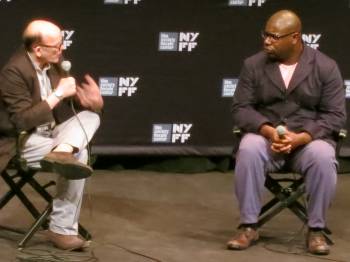
Gavin Smith and McQueen, NYFF P&I Q&A [Chris Knipp photo]
Walter Chaw's Telluride review says it better than I could -- why we cannot love yet cannot help admiring this film -- and makes close and telling comparisons with the book. Armond White was scathing in his condemnation, doubtless a partial reason for his expulsion from the New York Film Critics Circle.
Last edited by Chris Knipp; 01-02-2015 at 07:02 PM.
-
J.C. Chandor: ALL IS LOST (2013)
J.C. CHANDOR: ALL IS LOST (2013)
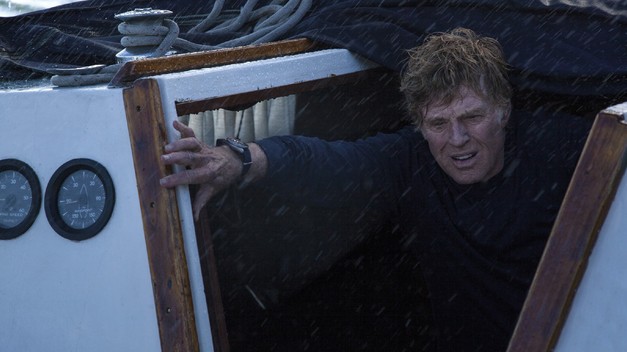
Robert Redford in All Is Lost
A sacrament of survival
The only appropriate thing to say about J.C. Chandor's highly original and brilliantly executed second feature is nothing, because it is wordless, or nearly so. It follows someone for days in a life and death struggle who hardly speaks at all. Our Man (Robert Redford) has gone away at sea in a nearly new, well-fitted 39-foot sailing yacht, far off in the Indian Ocean, adrift 1,700 nautical miles from the nearest land. He has left family behind. We hear a letter he wrote to them in voice over at first. "All is lost." He feels he has failed them. So he has gone. That's all we know, no back story, no details. Only the action. Which is dire, beginning at once. As he wakes up, a container that has fallen off a cargo ship, filled with running shoes, has just floated into the boat, and punctured it. It is filling with water. The boat has lost GPS, electronics, communications. The radio works after a while, but only for a few minutes. Our Man's SOS probably goes astray. He patches the hold. He saves what he can. He is becalmed. Then, a big storm comes. Then other things. This is a story of survival. It's like Beckett, without the words. This is a kind of pure cinema.
It is not silent. The sound design is interesting, rich, and important. Unfortunately, the filmmakers, like those behind Gravity, another current survival film of merit, set in space, forget that where their character is there are no string orchestras. It's not as bad as in Cuarón's film, but at times the music is obtrusive, and certainly unnecessary.
The screenplay reportedly is thirty pages long. It would be interesting to see it. Obviously, there is no dialogue. Redford has said that he admired how specific it was. As Our Man, he must perform a multitude of tasks and go through a multitude of motions, rather than "act." His expression is neutral. He is a good sailor, strong and adept for his age (Redford is 77), though not extraordinary. He reacts, he improvises. He does what he knows how to do. When the storm redoubles its efforts, the boat is beginning to sink. He has the life raft, the survival kit. He uses them. Floating out in the life raft he uses a map and instructions and a sextant, and relies on currants to sail into a shipping lane where he hopes to flag down a passing vessel. But when that doesn't succeed, it appears that all is indeed well and truly lost.
The beauty of All Is Lost is that you're wholly caught up in the action. At least it offers that opportunity to you. We live in an age of rampant inattention, and in front of me as I watched in the crowded cinema there was a man who regularly lighted his electronic device to check the time. Evidently he had somewhere more interesting to be. I did not. I relate well to pure visceral adventures. Think 127 Hours, only with a lot more going on, the deep sea below, a school of pilot fish, sharks circling, and the need to make drinkable water. But this is just as intimate and physical. Eventually Our Man, whom we've only heard reading the letter sent before he set sail, and briefly sending the futile SOS, throws his head back in the life raft and yells "FUUUUUUUUK!" And you know what he means.
Editing is fast and seamless. When Our Man climbs the mast, the camera moves around him, catching him from different angles. But it never seams self-conscious. If you are paying attention, you just don't think about it. And you don't think about Redford. Redford is the vessel for the action, no pun intended. He doesn't get in the way. He is like somebody performing a Japanese tea ceremony. A sacrament of survival. With his debut, Margin Call, Chandor made the best movie about Wall Street. Now he has made this. Is every movie he makes going to be the best of its kind?
All Is Lost, 106 mins., debuted at Cannes 22 May 2013, and has been shown at other international festivals, including New York, at Lincoln Center, where it was screened for this review. Release date US 18 Oct., UK 26 Dec.

Chandor and Redford at NYFF P&I Q&A [Chris Knipp photo]
Last edited by Chris Knipp; 01-02-2015 at 07:12 PM.
-
Alexander Payne: NEBRASKA (2013)
ALEXANDER PAYNE: NEBRASKA (2013)
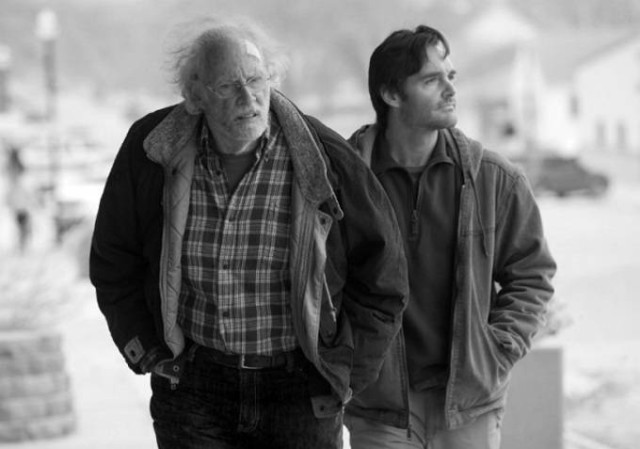
Bruce Dern and Will Fort in Nebraska
Father and son
Payne goes back to his state of origin, with another road trip, and is cruel in order to be kind in this heartbreaking little tale of a not very accomplished son Dave (Will Forte), who sells TV's and stereos (and has just been dumped by his live-in girlfriend), trying to spend some quality time with Woody (Bruce Dern), his alcoholic, eighty-ish, borderline-Alzheimer's father. But he doesn't have Alzheimer's, Dave says, he "just believes what people tell him." And he's gotten one of those letters promising him a million dollar Mega Sweepstakes Marketing prize and believes that. So Dave gives in to Woody's stupid, crazy attempts to head out to collect the nonexistent million dollars, takes time off from work and drives him from Billings, Montana to Lincoln, Nebraska for it, to shut him up, and spend some time with him. Only along the way they stop at the little town of Hawthorne in central Nebraska where Woody grew up, and there are scores to settle there and memories to return to.
Woody is a simple man. He speaks little, but he speaks truth. His wants are few. His only desire with the million dollars is a new pickup truck and a compressor. These are not things a man needs a million to buy. Davd may be able to make his father's dream come true.
Following a screenplay by Bob Nelson, shooting in no-nonsense digital black and white, Payne deftly handles what may seem a simple story but in fact works on many levels, private and public, present and past, and, of course, serious and comic. Woody's boozy naivete also serves as a laser beam to delineate the pettiness and greed of many and the authentic sweetness of a few in his old home town, with his blunt-spoken wife Kate (June Squibb of About Schmidt) also exposing secrets and lascivious details, when she comes to town too. Hovering in the occasional foreground also are Woody's older son Ross (Bob Odenkirk), a local Billings TV anchorman, and an old garage business partner, Ed Pegram (Stacy Keach), one of the greedy ones. But much of the little town turns greedy, when they hear the false rumor of Woody's coming wealth. There are a lot of inarticulate, nearly comatose old men too -- as well as mindlessly stupid younger men. This is where Payne's portrait of rural Nebraska, rural America, perhaps, becomes hilariously cruel. But the cruelty is offset by the sweetness that remains when all the pettiness has been sifted out.
The visit to Hawthorne is fleshed out with various events that inform Dave about Woody's past. The town would make him a celebrity, and sends a boy to shoot his photo. They go to the paper, and meet an old flame (Angela McEwan), who lost out to Kate. She shows him a story about his Korean war service; Ed Pegrem tells Dave about how Woody wanted to leave Kate for a Native American woman. When Kate and Ross show up they all go to visit the roomy farmhouse, now derelict, where Woody grew up, and an effort to settle a score with Ed leads to a comedy of errors.
This is not only a blunt picture of rural, working class America. It's a stark picture of families. And it's a clear-sighted look at age. While some looked at Payne's last film, The Descendants (NYFF 2011), as too conventional, a soap opera, others may look at this one as too caricatural. It's a tragicomedy, its heartbreaking realities freely laced with guffaws. It is, in any case, a wonderful opportunity for actors (who usually love to work with Payne), and a central role showcase for his talents Dern, who has so often played quirky character parts, had not expected to be given. It's an opportunity he took good advantage of, delivering a performance that is both funny and real. (He's said that the non-actors used in the film helped keep him honest and on his toes.) Also in every scene with Dern, Will Forte, mostly a comic and TV actor, has said he could hardly believe his luck in getting this part, and he too performs with a simple authenticity that touches the heart. This is the kind of film that may keep you laughing, and then get you starting to cry as you walk out of the cinema. For me The Descendants was richer and more enjoyable. But Nebraska may cut closer to the bone.
Nebraska, 115 mins., debuted in competition at Cannes, where Bruce Dern got the Best Actor award. It has shown in a number of other festivals including the New York Film Festival at Lincoln Center, where it was screened for this review. US release 22 Nov., UK 6 Dec.
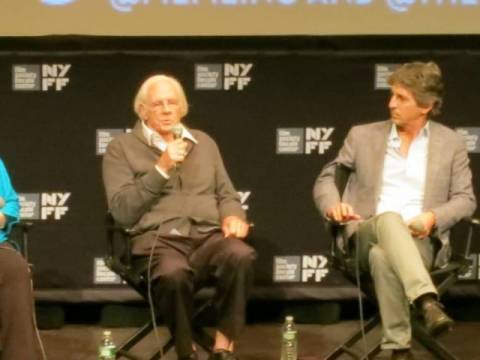
Bruce Dern and Alexander Payne at NYFF P&I Q&A [CK photo]
Last edited by Chris Knipp; 01-22-2020 at 11:55 PM.
-
Ralph Fiennes: THE INVISIBLE WOMAN (2013)
RALPH FIENNES: THE INVISIBLE WOMAN (2013)
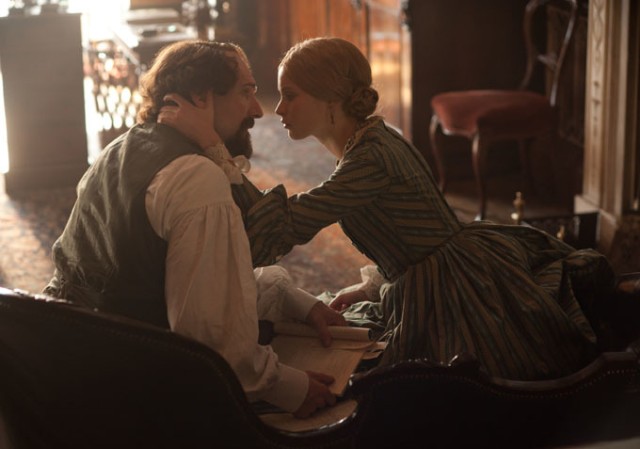
Ralph Fiennes and Felicity Jones in The Invisible Woman
An unexciting secret
Do not look for passion in Ralph Fiennes' second outing as director. It's a tepid account of Charles Dickens' thirteen-year affair with a young actress, Ellen Ternan, in which the children's costumes, the Victorian interiors, and an accurately staged train wreck are more interesting than the main action. Fiennes himself plays Dickens, and Felicity Jones plays Ellen or Nelly. The Invisible Woman, unlike Fiennes' directorial debut, a raw modern-day staging of Shakespeare's Coriolanus, is a worshipful costume piece that barely has a pulse. Arty moments -- Ellen pacing on the dunes, blurry extreme closeups, and surges of ridiculously loud string music -- do not alter the conventionality of the whole. Kristen Scott Thomas as Ellen's mother Frances Ternan and Tom Hollander as Wilkie Collins are among the actors lost amid the maundering and gloom.
Things begin badly with a pedestrian framing passage of Ternan years later when she is married with kids and she and her husband run a school at Margate (though East Sussex is the location used in the film). Then we're switched to years earlier and a new set of people, when Dickens spots the eighteen-year-old in a play, and we eventually learn that she, her two elder sisters, and their mother (Scott Thomas) all tour, but she's the least talented. History recounts that Ellen was a vibrant and intelligent woman. This screenplay by Abi Morgan (based on a book by Claire Tomalin) conveys only that she worshipped Dickens' writing -- and wasn't such a good actress. Eventually the writer supported her, she stopped acting, and they remained lovers till he died in 1870 leaving her (not mentioned in the film, which is vague about dates) with an income for life.
When the two meet Dickens is at the height of his fame and is rich from his books and reading tours. He has ten children. His wife, Catherine (Joanna Scanlan, excellent but like others, wasted) has grown fat. The actress is forced to appear briefly nude, apparently to explain why Dickens might find her no longer attractive. Dickens pursues meetings and Catherine and Frances notice his interest in the girl. This is not exciting to watch. A highlight, such as it is, is an evening when the two stay up late alone counting money Dickens has raised for illegitimate children. Before that a brief encounter between Dickens and a prostitute (whom he primly rebuffs) and a tableau of dirty street children is the only sequence of a "Dickensian" world beyond the cushy tameness of the film.
History recounts that matters came to a head when a piece of jewelry meant as a gift from Dickens to the young woman was delivered by mistake to Catherine. The film gives Catherine the further humiliation of being sent by Dickens to deliver the jewel to Ellen and acknowledge the relationship. She also explains that for her husband, the public role as great author may outweigh personal ones. This is telling, rather than showing. But it has been shown that Dickens broadcast his separation from Catherine in a newspaper column, and that is how the family found out about it.
The toothy young Jones was Cordelia in the feature film Brideshead Revisited and Miranda in Julie Taymor's Tempest. She has radiance and youth (though actually thirty) but gets no interesting lines or strong scenes. But the point, though it undercuts the romance, is that Nelly is old fashioned and reticent. By the time she gives in we may have lost interest. And then after all the delay the full-on affair is rushed through. Maybe it's not the point. But then what is? It's hastily shown that Dickens installs Ellen in a house. They finally have sex, eighty minutes in, she gets pregnant (and wanders in the grass) and the baby dies in infancy, in France (a conjecture the film insists on). Yet it's hard to understand what he's talking about when Dickens says Ellen has been all his inspiration for a very long time, felt in every line he writes. The screenplay does not bring to life that inspiration.
The Staplehurst rail crash on 9 June 1865, so nicely recreated here with a dramatic mash-up of period-style railway cabinetry, comes when Dickens and Ternan are regularly traveling together. It shows their affair remains secret. She's injured and apparently in shock, yet he leaves her and pretends he is traveling alone.
None of this is a flattering picture of Charles Dickens. The reason for this tale being a subject of fascination, the topic of a play, two TV docudramas, a number of books, and this film, is not because so much is known (all correspondence and records surrounding it were destroyed) or that it's a great romance, but because Dickens is a writer of such importance in English fiction and because until all Dickens' children had died it was kept a secret. Avoid this film and watch instead Terrance Davies' superb screen version of Terrance Rattigan's The Deep Blue Sea. Hopefully Fiennes will drop the Masterpiece Theater schtick and surprise us again as he did with Coriolanus.
The Invisible Woman, 111 mins., debuted at Telluride in Aug., showed at Toronto in Sept., and also 9 Oct. at the New York Film Festival at Lincoln Center, where it was screened for this review. The NYFF is also presenting a tribute to Ralph Fiennes the evening of 9 Oct. at Alice Tully Hall. The film releases in the US Christmas 2013, and in the UK 7th Feb. 2014. Sony Pictures Classics, of course.
Last edited by Chris Knipp; 01-02-2015 at 07:22 PM.
 Posting Permissions
Posting Permissions
- You may not post new threads
- You may not post replies
- You may not post attachments
- You may not edit your posts
-
Forum Rules





 Reply With Quote
Reply With Quote









Bookmarks